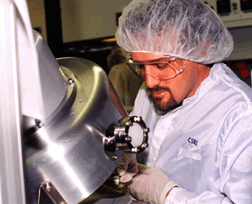|
Tool is miniaturized version of traditional collector
Tiny sampling device promises big results for detection and analysis of chemicals
|

TINY CHEMICAL SAMPLING DEVICE — Sandia researcher Ron Manginell examines a superminiaturized preconcentrator used to collect sample gases for analysis.
Download 300dpi JPEG image, ‘precon.jpg’, 263K (Media are welcome to download/publish this image with related news stories.)
|
ALBUQUERQUE, N.M. — A chemical sampling device smaller than the tip of a fingernail promises big results for detecting and analyzing trace chemicals.
The tool, developed by the Department of Energy’s Sandia National Laboratories, is a super miniaturized version of a traditional preconcentrator used to collect sample gases for analysis. The active area of the device is only two millimeters by two millimeters.
Already part of Sandia’s initiative to build a hand-held “chemistry laboratory,” it potentially can be integrated with other micro chemical detectors, including a mass spectrometer or an ion mobility spectrometer.
The miniaturized size will allow chemical testing using small hand-held instruments, eliminating the need to send samples to a large laboratory. This would be beneficial, for example, to a soldier in battle who needs to know immediately what chemical he is encountering. He doesn’t have a laboratory handy and doesn’t have hours to wait for an analysis.
“Because it can work with different types of microanalytical systems, this device is receiving a lot of attention,” says researcher Ron Manginell, who has been working on the preconcentrator for the past three years. “It’s small, uses minute amounts of power, is extremely portable, and is inexpensive to produce — all making it very interesting to both industry and the military.”
A traditional preconcentrator consists of a cigarette-size stainless steel tube packed with an adsorbent material. A pump forces the sample gas through the tube where it is adsorbed into the material. The steel tube then goes into a benchtop thermal desorber and is heated to 200 degrees C. The gas escapes from the tube for analysis by a detector such as a benchtop gas chromatograph system that determines the chemical’s nature.
Manginell says this traditional system is bulky, slow, and must be done in a laboratory setting — not at all practical for field testing.
Project lead Greg Frye-Mason says the microfabricated planar preconcentrator is a revolution in front-end sampling devices. Using standard integrated circuit microfabrication technology that allows 200 units to be built on a single four-inch silicon wafer, it has a silicon base topped by a one-half micron layer of silicon nitride. The silicon nitride membrane, formed by etching the silicon away, holds a patterned platinum heater, called a microhotplate. A thin layer of an adsorbent material goes on the front surface of the heater. Gold pads surround the device and help to connect the platinum heater electrically to the macroscopic world.
The micro preconcentrator operates much like its larger relative. First, a small pump pulls air containing a chemical over the adsorbent material. Current flows through the platinum, heating up the microhotplate to 200 degrees C. The high temperature causes the chemical to be released from the adsorbent material so it can be analyzed by a micro detector system.
“All this happens in the blink of an eye,” Frye-Mason says. “It takes six milliseconds and 100 milliwatts of power to reach 200 degrees. That’s 1,000 times faster than using the conventional method.”
It does this because the device is so small that it doesn’t take much current or time to heat up. This small size and planar design make the device ideal for chip-based microanalytical systems such as the Sandia’s chem-lab-on-a-chip concept.
The adsorbent material most frequently used in testing the device has been a sol gel developed by Sandia researcher Jeff Brinker. The gel can be “tuned” to collect certain types of molecules and not others. The researchers have also tested other adsorbent materials with the microfabricated planar concentrator.
Manginell, who has been involved in the device’s design, modeling, fabrication, thermal testing, and packaging, says work on the miniaturized preconcentrator started about three years ago.
“The initial development was fast,” he recalls. “It took us six months to come up with a prototype. Since then we’ve been refining and modeling it.”
Sandia is interested in distributing as many of its news releases as possible via email. We
are learning that an increasing percentage of people who receive them also want them in this manner. If you prefer to begin receiving news releases via email, please let us know by:
- Replying via email to ioaboyt@sandia.gov;
- Replying by fax to (505) 844-0645;
- Calling Iris Aboytes at (505) 844-2282.
Please also recall that Sandia news releases are posted on the World Wide Web at
http://www.sandia.gov/News.htm
|
Sandia is a multiprogram laboratory operated by Sandia Corporation, a Lockheed Martin Company, for the United States Department of Energy under contract DE-AC04-94AL85000. With main facilities in Albuquerque, N.M., and Livermore, Calif., Sandia has major research and development responsibilities in national security, energy and environmental technologies, and economic competitiveness.
Media contact:
Chris Burroughs, coburro@sandia.gov, (505) 844-0948
Technical contacts:
Greg Frye-Mason, gcfrye@sandia.gov, (505) 844-0787
Ron Manginell, rpmangi@sandia.gov, (505) 845-8223
|
